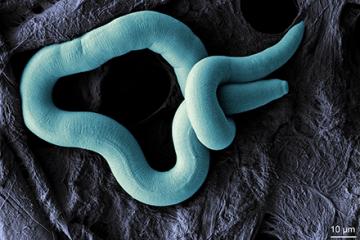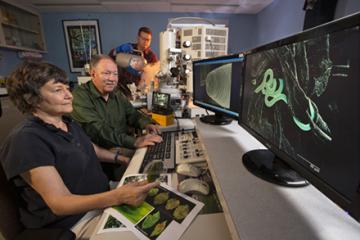What’s Killing Beech Trees?

A low temperature scanning electron microscope (LT-SEM) of a mature female nematode, Litylenchus crenatae, found in the leaves of beech trees. (Electron and Confocal Microscopy Unit; colorization by Joe Mowery, D4260-1)
A chance discovery in an Ohio woodland has turned into a multi-disciplinary, multi-agency, and multi-national effort to piece together a puzzle and understand a scourge that is killing trees by the thousands in northern states east of the Great Plains.
The leaves of young beech trees are failing somehow. Scientists have figured out what causes the malady; it’s the ‘how’ that has them scratching their heads.
Beech trees are one of the most common trees in America’s northern and northeastern forests. Their nut crop feeds birds and other animals, and its wood is prized for bentwood furniture.
The symptoms of beech leaf disease were plain to see – sunken dark spots on the leaves, which eventually died – but opinions differed on the cause. Was it bacterial, fungal, or viral? Then, a plant pathologist working for the State of Ohio noticed wiggly things in the leaf lesions. They turned out to be nematodes, microscopic worms that live in the soil, that had somehow managed to make it to the tree canopy 40-50 feet above ground.
Nematode samples were sent to Beltsville, MD, for analysis and identification at the Agricultural Research Service (ARS) Mycology and Nematology Genetic Diversity and Biology Laboratory in Beltsville, MD. The nematode, Litylenchus crenatae, turned out to be native to Japan – the first population of L. crenatae found in the Western Hemisphere. The curious thing is that it’s not a tree-killer in Japan.

At the Electron and Confocal Microscopy Unit, in Beltsville, MD, from left to right, plant pathologist Lynn Carta, lab director Gary Bauchan, and support scientist Joe Mowery use a low-temperature scanning electron microscope to observe a nematode, Litylenchus crenatae, that is damaging beech trees. (Stephen Ausmus, D4239-1)
“I don’t think anyone who knows nematodes doubts that the nematode is causing the symptoms,” said Lynn Carta, a research plant pathologist in Beltsville. “The question is, why is the disease more virulent here in the United States?”
In addition to ARS scientists, researchers from Canada, Japan, and New Zealand are trying to find the answer to that question. In New Zealand, another species of the Litylenchus nematode causes similar symptoms, except it affects bushes rather than trees.
“We secured a promise of DNA from Japan and New Zealand, so in a few months we’ll be able to test DNA from those to get a very specific set for a real-time PCR test that will allow anyone doing surveys to get an accurate diagnosis in a very short time,” Carta said. PCR stands for polymerase chain reaction, a test used to increase trace amounts of DNA.
The researchers also want to understand how the invasive nematode is moving. So far, it has spread eastward from the Great Lakes region, with the southernmost detection of symptomatic leaves with nematodes being near Pittsburgh, PA. Carta noted that the migration appears to follow the prevailing winds.
The nematodes could be hitching rides on imported plants, on mites, or even in birds. Some mites – very small arthropods – travel on the wind while others climb up the tree trunk. Birds have been known to eat plant cysts that contain nematodes and then “deposit” them later, the cysts having protected the nematodes during the digestive process.
Once all the puzzle pieces come together, the scientists can better explore methods to control this devastating pest. – By Scott Elliott, ARS Office of Communications.

